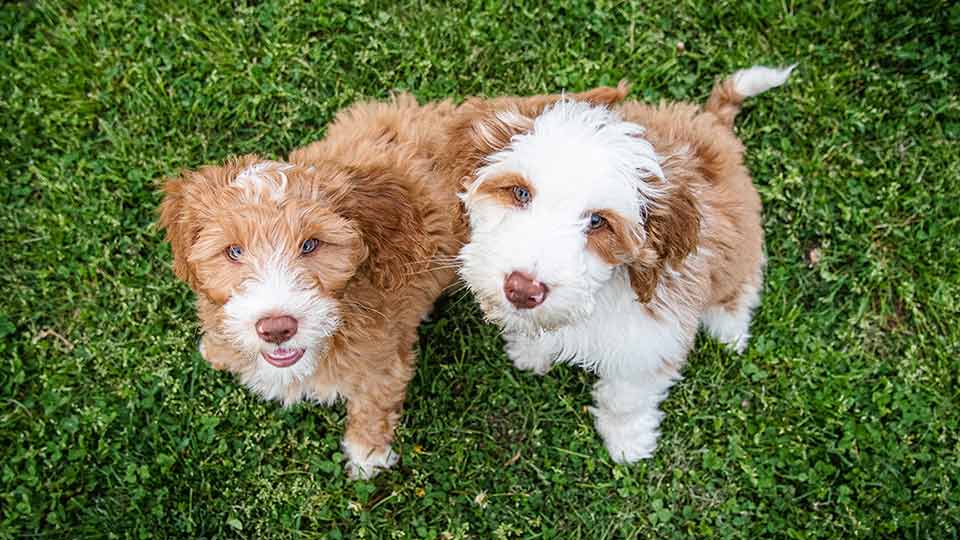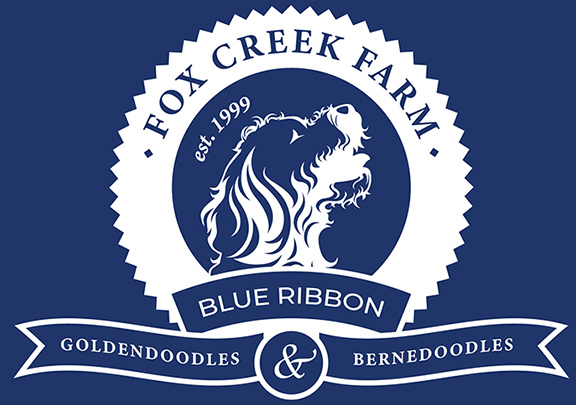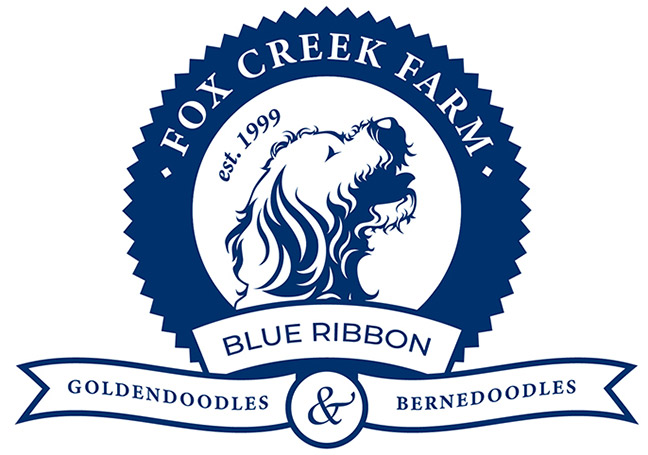Our Goldendoodle Program At Fox Creek Farm

The Main Goldendoodle Characteristics
The Goldendoodle dog breed has proven to be a highly intelligent, easy to train dog with “gentle” being the most commonly used single word to describe them. Goldendoodles (or as some call it – Golden Doodles) have a beautiful long coat that comes in three types – straight, wavy, or curly. Goldendoodles require regular brushing a few times a week to avoid matting and typically require professional grooming about every six weeks. New DNA technology is constantly evolving and we now can test for the number of curl genes as well as shedding genes a dog carries. This information is used in the selection of breeding pairs to assist us in creating the most hypo-allergenic dogs possible. Most multigen Goldendoodles do not shed regardless of the type of coat they possess. There is outdated info to be found on the World Wide Web that says that the curlier the coat, the better chance adult Goldendoodles will possess non-shedding coats. This information was originally an educated guess by breeders of Goldendoodles who did not have DNA technology and testing available at the time. It was thought that if a full grown Goldendoodle had a curly coat, it possessed more of the Poodle genes. Since the Poodle was the non-shedding contributor to the mix, the expression of a Poodle-like coat may mean a better chance the coat would have the same traits as the Poodle. With the advancement of DNA testing available to breeders, this myth has been debunked. Even multigen Goldendoodles with a straight coat can be non-shedding as the genes responsible for shedding come from the lack of furnishing genes. Beware of breeders that still operate under the assumption that curly coats equate to non-shedding. The furnishing genes are responsible for the longer facial hair typical of breeds that do not shed, ie: Poodles, Shih Tzus, Yorkshire Terriers, Sheepdogs, etc. When searching for hypo-allergenic Goldendoodles for sale, this is an important aspect of testing that cannot be left out. Be sure to ask the breeder about the DNA testing completed on each parent dog. Most reputable breeders will have the testing accessible by a link on their website.
Goldendoodle Sizes and Generations Chart
The F1 standard Goldendoodle was the first to be bred. It is the product of a standard Poodle crossed with a Golden Retriever. These full grown big Goldendoodles have a typical mature weight of 50-75 lb. In some pairings, these dogs may even exceed 100 lb.
The F1 medium Goldendoodle is the product of a mini Poodle crossed with a Golden Retriever. The average Goldendoodle weight in this size range is 36-50 lb.
The F1 mini Goldendoodle is the product of a miniature or toy Poodle crossed with a Golden Retriever. The mini Goldendoodle adult size ranges from 26-35 lb. and have a 50% chance of being low shedding.
The F1B Goldendoodle is produced by crossing an F1 Goldendoodle with a Poodle. The mature adult weight is determined by the size of the parents. These dogs will have a higher success rate for non-shedding over the F1 generation. Because this generation has another Poodle ancestor, this is the first generation that may produce petite Goldendoodles maturing to less than 25 lb. if the B represents a mini or toy Poodle. However, if the B represents the F1 Goldendoodle being bred back to a Golden Retriever, the mature size will be increased as will the shedding factor. Mini multigen Goldendoodles typically are produced from these smaller lines when the B represents a smaller Poodle.
The multigen Goldendoodle is the product of two Goldendoodle parents. Please see the Goldendoodle Generation Breeding Chart below for an explanation on what two generations of Goldendoodles bred together constitute the creation of a multigen litter. The multigen with two furnishing genes and a long coat is the most hypo-allergenic with a 98% non-shedding success rate. Here at Fox Creek Farm, we specialize in this type of breeding. Even though we cater to customers with no known dog allergies as well as those who suffer from this unfortunate condition, we have never been asked to provide a family with a dog that definitely sheds! It seems everyone enjoys the lack of dog hair on the furniture, clothes, and floating through the air!
The most popular type of Goldendoodle that we get requests for are the fully DNA tested multigen mini Goldendoodle or teacup Goldendoodle. Get to know the mini Goldendoodle and you might just fall in love at first sight.
Goldendoodle Size Categories:
- Petite range: Height: below 14 inches at withers, typically 25 lbs. or less
- Miniature range: Height: over 14 but under 17 inches at withers, typically 26-35 lb.
- Medium range: Height: over 17 but under 21 inches at withers, typically 36-50 lb.
- Standard range: Height: over 21 inches at withers, typically 51 or more lb.
Final size category of a dog will be determined at adulthood and is measured at the withers. Please be aware that the estimated size of a puppy by a breeder is an educated guess. Therefore, a puppy’s final size may vary somewhat from a breeder’s initial calculation. Most experienced breeders will survey their puppy families as their puppies reach maturity to survey and document adult height and weight. Tracking this type of information helps a breeder to understand what sizes certain dogs carry in their DNA and how those size genes are expressed based on the breeding partner. This works best when it is a repeat breeding of the same parents, but will also give some insight into each individual dog’s contribution to the gene pool. Working with a breeder that documents not only height and weight information, but also temperament, health, and longevity will help you find the right breeder, and then the right puppy, to complete your family.
Goldendoodle Colors:
Goldendoodles can exhibit pretty much any color, multiple colors, or coat patterns found in all other breeds. The most common are the golden/apricot and blonde/cream solid colored coats. The solid colors can range from blonde/cream, to apricot/golden, to red and can also come in black, brown/chocolate, white, and grey/silver. All of these colors can also come in abstract or tuxedo meaning there is typically white on the chest, face, and paws. Goldendoodles can even be tri colored with black, brown, and white similar to a Bernese Mountain Dog. Parti combinations are any single color mixed with white patches and the white has to cover more than 50% of the body. Other color patterns are merle, phantom, brindle, and sable. It takes a breeder that is educated in the science of color DNA to determine what can be produced when pairing two Goldendoodles together. It is critical that only one dog carries for merle to avoid producing puppies that are affected with blindness and deafness. While many people have a preconceived picture of the ideal Goldendoodle in their mind including their preferred color, it is important to realize that color should always rank second to temperament. Many times the color is given too much weight and should never be the deciding factor on which puppy in a litter would be the best fit for their family. It is also important to note that some colors will fade and the adult coat will be a very different shade when compared to the color of the puppy coat.
Goldendoodle Generation Breeding Chart Grading Scheme by GANA (Goldendoodle Association of North America)
- F1 = Golden Retriever x Poodle
- F1B = F1 Goldendoodle x Poodle or F1 Goldendoodle x Golden Retriever
- F2 = F1 Goldendoodle x F1 Goldendoodle
- Multigen = Two Goldendoodle parents – One parent has to be an F1B or multigen. A Poodle or a Golden Retriever bred to a multigen Goldendoodle also constitutes a multigen. Note that in the F1B generation, if the B represents the Golden Retriever, the size of the offspring will likely be increased as will the amount of shedding. A high number of puppies in this type of pairing will be lacking the second furnishing gene necessary to avoid shedding. There will likely also be offspring that inherited no furnishing genes which results in what is called a flat coated Goldendoodle. This type of Goldendoodle will have a similar coat to a Golden Retriever that typically does not continue to grow and provide the fluffy coat typically associated with Goldendoodles. The flat coated Goldendoodle will also have a smooth, short-haired muzzle. Flat coated Goldendoodles are not recommended to families who have a member with allergies to dogs.



